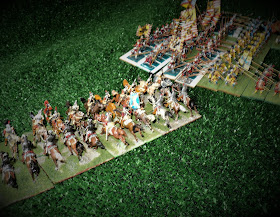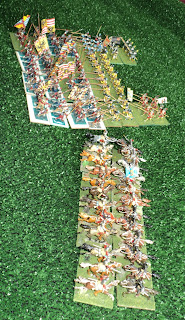I've just been re-reading my previous posting, and the comments that followed. Some remarks by Neil Patterson reminded me of a half-forgotten still-born project from 45 years ago. To this day, I think about it from time to time with a certain wistfulness. Like one of Neil's concepts, this was set in the Balkans - or at least, a Balkanish sort of region. But the period setting was Late Mediaeval/ Early Renaissance.
 |
| Battle of Jazzynitza Lug - as recalled - between the City State of Dubius and Monteblanco. The original battle used Airfix 'Sheriff of Nottingham' and 'Robin Hood' figures. |
Somewhere upon the Eastern Adriatic littoral...
Being 'Balkanish', the region - its name lost to antiquity - was split up into several rival States, of varying size and military strength. Each state had its own specialist troop type - one large state of rolling grass plains was famed for its horses, hence for its cavalry; another, a heavily forested alpine province, favoured the pike; the City State (somewhere upon the Adriatic(?) coast) was renowned for its arquebusiers. I think knights, archers and crossbow men also were to feature. Probably everyone might field ordinary humble spearmen.
The whole thing was envisaged as a multi-player game. As a result of the military specialisation among the States, it could be imagined that a certain amount of arms dealing was intended to occur, to supply deficiencies in each other's armed forces. So this called for a certain amount of cooperation among the States. Of course, having acquired a consignment of pikes from 'Pikeland', didn't prevent one from using them against 'Pikeland' subsequently - unless you 'bought' the men that went with them. I don't recall whether the campaign involved mercenaries - or how.
I have a feeling this market in arms was predominantly to take the form of trade - of barter - rather than monetary deals. Don't recall exactly. Economic factors were generally pretty fudged out of consideration, but there must have been production and financial constraints upon the manner in which States could develop their military.
For each State, the objective was to become the hegemon overall - very like the Diplomacy board game in that regard. It was impossible, however, for even for the most powerful State to 'go it alone', so alliances and non-aggression deals were de rigueur for even mere survival. In such situations, there was always the possibility of States 'ganging up' against a single State, or perhaps unfair trade sanctions being imposed. To keep the 'States' honest the Game Director had what I called the 'Umpire's Sanction'.
It was called the Nordic Horde.
Now, the figures in use for this whole project were Airfix: 'Sheriff of Nottingham' and 'Robin Hood' figures. Quite a lot of the Nottingham spearmen lost their spears and received in return sturdy wire pikes - at least 72 such figures, as I recall from one of the 'test' battles fought. I don't recall where the arquebusiers came from - some adaptation of the plastics, I'm sure.
So, whence came the Nordic Horde? Airfix Ancient Britons. Hordes of 'em. That is why this Horde was Nordic rather than Asiatic, I suspect. When the Nordic Horde was feeling restless (at the 'Umpire's' discretion), the 'Balkan States' pretty much had to drop everything and fend them off. So powerful was 'The Horde', that if just two States stood aloof from the threat, the likelihood was that the whole region would be overrun, and sink into a Nordic Dark Age. End of Game.
 |
| Battle play test. The City State horse (right) broke their opponents, to win the battle. |
I recall that Philip - the inventor of this 'project' - and I played a couple of small games to test his very simple game rules (derived from Young and Lawford's Charge!). In one of these he had a force of perhaps 12 or 20 cavalry, and 4 12-figure pike blocks each arranged in 4 ranks of 3 figures. I had as many horse, 2 pike blocks and a 12-figure unit of arquebusiers. Having fewer than 60 or 70 figures a side, the thing was fought on a desk top. As the infantry fight gradually developed in Philip's favour, the even cavalry fight went, by sheer luck, quickly and decisively my way.
The next battlefield featured a lot of hedged enclosures, with one gateway, which sole defile might be negotiated by cavalry in single file. That pretty much neutralised my cavalry out of the action. A canny operator, was Philip! But it rather defeated the purpose of the play test, methinks.
It was a pity that time, marching on as it usually does in step with 'real life events' (one of which was my leaving Auckland to take up work in Wellington), didn't lead to the project getting any further off the ground. I've always thought it a promising concept - provided, of course, you got together at least a half dozen like-minded war gamers ready to give it a serious go. I have occasionally toyed with reviving it, but have been forced to conclude that the practical difficulties would be beyond my capacity to overcome them.
Unless I played it solo.
Mabutuland.
That brings me to a project behind which lies the motivating force of my war games buddy, Paul, a.k.a. 'Jacko' of the occasional blog spot, paintinglittlesoldiers. I would like to see more happening with that blog, but there also happens to be another that has seen no action for several years: The Empire of Jaxonia. This one, though, I hope will see something happening, and this blogspot revivified.
Think: East Africa, c.1880, not so far from the offshore island of Madasahatta, with ambitious colonial powers, Arab raiders, Turkish traffickers in ivory, gold and persons, and the fearsome indigenous tribes wishing everyone else would go away, and leave them in peace to fight among themselves.
I believe the framework is similar in overall concept to Space 1888, which might be played as a war game, or as a role-playing game. The RPG aspect offers local sub-plots within a much broader narrative. The inspiration for this comes from Ubonga: A Solo Campaign from Darkest Africa. Having some 100 'spare' Zulu Wars British figures, I have offered to create a company-sized force garrisoning some up-river fortified outpost, though I admit that the logistical backup would probably be wanting. I have suggested that one of the main rivers be called the 'great grey-green greasy Limpopo River, which is as deep as the sea, and bordered with fever trees', just because I like saying 'the great grey-green... etc'.
 |
| Schematic of HMS Thunderer that will form the basis of the construction of HMS Blunderer |
On the strength of it, though, I have begun building a coastal battleship based on the old HMS Thunderer (to be called, I think, HMS Blunderer), forming a small flotilla together with a Fly Class gunboat, and an assortment of paddlesteamers and tenders. Other nations might get some ex-American Civil War riverine craft, sold them by a canny US government with an eye for a buck.
All this so far is pretty vague, very much in its early stages. But 'Jacko' has done quite a lot of work on developing the factions and forces. Not only that, but he's got hold of the map for the S&T Magazine game: Sideshow - German East Africa, 1914-18. Possibly my own Ruberians, Azurians and Turkowazians will have a role to play in what is, in certain respects, really quite a vast undertaking. I hope to have more to write on this topic later on.






